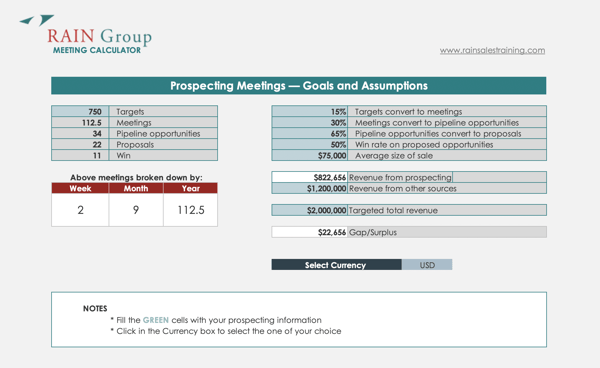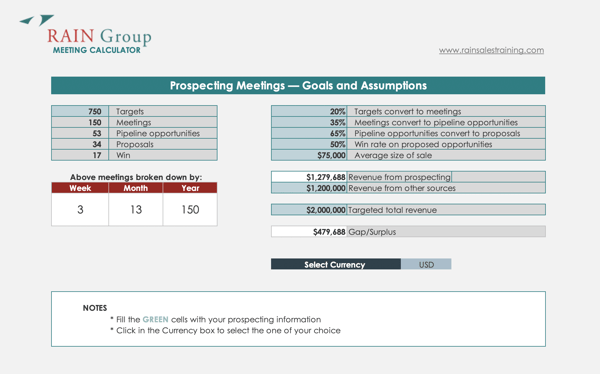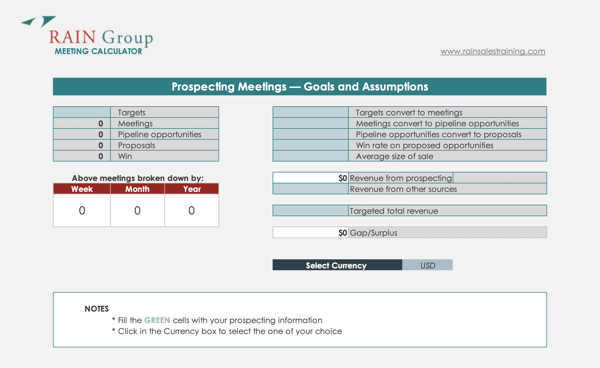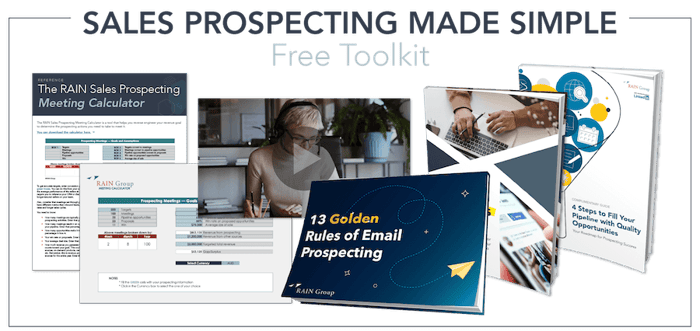Do you know what it’s going to take to reach your sales target?
It’s not enough to have a quota or even set goals for yourself—you need to know exactly what to do daily to accomplish your goals.
Some sellers have no better than a vague idea of how to hit their numbers. Some have a solid understanding of the prospecting activities necessary to reach targets, but they’re unsure how to get predictable results.
To reliably meet and exceed your targets, you need to start with a solid understanding of pipeline metrics and understand how to analyze prospecting numbers.
TL;DR? The video below breaks down how to rethink your pipeline and use our Sales Prospecting Meeting Calculator to meet your goals.

How to Meet Your Prospecting Goals
Before you begin any prospecting outreach, you need to have a specific plan that answers these questions:
- How many new opportunity-driving meetings do you need to set to reach your sales targets in a defined timeframe?
- How much time do you need to spend prospecting to generate those meetings?
- What do your sales process conversion metrics need to look like to turn those meetings into enough sales to beat your goals?
It’s only after you have an idea of how to get to your goal that you can start planning your actions.
Begin by breaking down the numbers. This will reveal:
- How many people you need to target with your Attraction Campaign to generate enough meetings
- How many meetings you need to set with your targets to drive new business
- How many of these meetings will hit the pipeline as opportunities (as opposed to producing nothing)
- How many of these opportunities you need to qualify and then propose new business to
- How many sales wins you’ll achieve for each proposal delivered, and at what revenue levels, so you can hit your goal
Faced with this, some sellers say, “I don’t know how to figure this out,” or, “I’m not a math person.”
That’s where the RAIN Sales Prospecting Meeting Calculator comes in. It’s a tool to help sellers break down their numbers and eliminate guesswork. You can download it as part of our Sales Prospecting Made Simple Toolkit—it only takes a few minutes to download and fill out.
Let’s take a closer look at the tool and what you need to get started.
Pipeline Metrics by the Numbers
Before you can crunch any numbers, there are a few preliminary prospecting metrics you’ll need to plug in to get started, each represented by one of the green-colored cells:
- Targets
- Targets convert to meetings
- Meetings convert to pipeline opportunities
- Pipeline opportunities convert to proposals
- Win rate on proposed opportunities
- Average size of sales
- Revenue from prospecting
- Revenue from other sources
- Targeted total revenue
At first, start by putting in any number of prospects—50, 200, 500—and fill out the rest of the data with guesses, then see what happens. Get a feel for the tool and how various changes affect the outcomes.
If you don’t have a basis to make guesstimates, talk to experienced peers and your sales manager to find a starting point. Later, you can test the numbers with your manager or coach to solidify your plan.
In any case, once you input these initial numbers, let the calculator take care of the rest.
What happens once you get a meeting? Read 7 Steps to a Successful Sales Meeting. >>
How to Analyze Your Sales Prospecting Numbers (Example)
Let’s take a closer look at the tool and share an example of how it works.
Assume you need to sell $2 million by the end of the year. You believe, based on your repeat business data, that you can rely on existing customers to make up about $1.2 million of revenue. This means you need to generate $800,000 in new business. Your average sale size is $75,000, which means you need 11 new business closes.

Since you know your average win rate on a proposal for new business is 50%, you know you need 22 proposals.
However, not every opportunity in your pipeline will eventually go to proposal. Assuming your pipeline opportunity-to-proposal conversion rate is 65%, you’ll need 34 opportunities in your pipeline.
Now the prospecting analysis starts.
Not every meeting you set through your prospecting efforts will result in a pipeline opportunity. Ask yourself how many will enter the pipeline in a short period of time, and how many will say either, “Thanks, but no thanks,” or, “Maybe in the future, but not now”?
Let’s say 3 out of 10 meetings result in an interested prospect, meaning 30% of them enter your pipeline.
That means you need 113 initial prospecting-set meetings over the course of a year to generate the 34 pipeline opportunities.
Now you need to determine how many unique people you’re going to target, and reach out to, to generate those meetings.
Let’s say for every Attraction Campaign you run, you set meetings with 15% of the targets. This means you’d need 750 unique targets to generate 113 meetings.
While this might seem like a lot to some people, it all depends on your business and situation. Breaking this number down makes it much more manageable. If you have 750 targets, that means you only need to initiate contact with 188 per quarter. That’s only 62 a month, and only just over 14 new prospects contacted per week.
And the number itself depends on your situation. We know sellers who only have 50 targets, but the business with each target is worth millions. We also know sellers who are required to make 70 custom outreaches a day to thousands of people a year and manage the pipeline that they generate. They never let up because, if they do, they won’t reach their goals.
The question is, what number is best for you?
Further Refine Your Sales Pipeline Metrics
Let’s take a look at what happens if your prospecting and pipeline conversion metrics improve. Instead of getting through to 15% of buyers, you connect and set meetings with 20%. Rather than 30% entering your pipeline, it’s now 35% because your initial meeting conversation skills improve.
While you might have generated $800,000 in revenue before, now you’re generating $1.3 million.

If you know your numbers, you can plan your outreach to hit your goals accordingly.
You also need to consider other factors, such as:
- How much you have in your pipeline now: What can you already account for this year and remove from your calculations?
- How fast you get repeat business: Higher rates of repeat business will reduce the amount you need to bring in from the outside.
- Sales cycle timing: If you need all the leads to generate revenue this year, and your sales cycle is 100 days, you’ll need these all in your pipeline 100 days before year-end. Thus, your meetings will need to be set sooner if you don’t have enough in your pipeline now to close the gap.
Also, consider that leads set through prospecting often have different metrics than inbound leads, such as lower conversion rates and longer sales cycles.
As for where to start, many people tend to ask, “Well, what are the averages across sellers in general? I can start with the averages.” Beware of averages, as they vary drastically among different companies, industries, and roles.
A much better place to start is with data from your company for what the actual metrics are on average and for top sales performers.
Before you start sending emails and making calls, break down your goals with the RAIN Sales Prospecting Meeting Calculator. You’ll learn how many meetings you need to generate every month and be able to organize your time and energy to get ahead of your goals.
Get the Sales Prospecting Meeting Calculator and more resources to take the guesswork out of your outreach with our Sales Prospecting Made Simple Toolkit. Download now. >>








